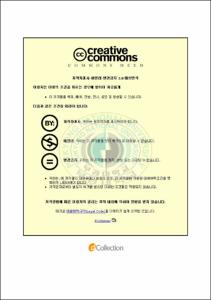Biosorption of Heavy Metals from Aqueous Solutions by Bacteria Strains Isolated from Contaminated Soils
- Alternative Title
- 오염된 토양에서 분리한 미생물을 이용한 수용액 내 중금속 생물흡착 연구
- Abstract
- Batch experiments were performed to investigate heavy metal removal efficiency of biosorption by using bacterial strains isolated from polluted soil. The bacterial strains were identified as Ralstonia sp. and Bacillus sp. from two oil contaminated sites, Korea.
For batch sorption experiments with various amount of biosorbent, removal efficiencies of Cd, Cu, Pb and Cr by adding 0.5 g of Ralstonia sp. were removed more than 90 %. By adding 0.2 g of Bacillus sp., the removal efficiencies of Cd, Cu, Pb and Zn from solution were over 90 %. From the experiments, the optimum amount of Ralstonia sp. and Bacillus sp. for biosorption of heavy metals ions(from solution) was determined as 0.5 g and 0.2 g for 50 ml solution, respectively. In case of various pH conditions(by adding 0.5 g of the biosorbent), removal efficiencies of Cd, Cu, and Pb were very low at pH 1 of solution, but they increased at pH 2 and maximized at pH 3 ~ 5. In case of sorption experiment at different reaction time, the removal efficiencies of Ralstonia sp. for Cu, Cd, and Pb were reached over 90 %(85 % for Bacillus sp.) within 10 min of reaction time and they maintained as the time increased. From the results of experiment applying different intial heavy metal concentrations in solution, removal efficiencies of Cu and Pb using Ralstonia sp. linearly increased with the increase of the initial metal concentration. However, the capability of Bacillus sp. to absorb heavy metals reduced(the removal efficiency lowered to less than 30 %) when the initial concentrations of Cd, Cu, and Pb were over 20 mg/L. From the results of fitting process for sorption data to Freundlich and Langmuir isotherms, they were recognized that the biosorption isotherms of Cd, Cu, and Pb were more well fitted to Freundlich model rather than Langmuir model(r2> 0.96). Freundlich sorption coefficient(Kf) of heavy metals for Ralstonia sp. and Bacillus sp. ranged from 640 to 760 and from 121 to 221, respectively. The values of sorption coefficients and constants for Ralstonia sp. were higher than those for Bacillus sp., suggesting that Ralstonia sp. has higher sorption capacity than Bacillus sp.. The results indicated that bacterial strains, Ralstonia sp. and Bacillus sp. are a suitable biosorbent for the removal of heavy metals from aqueous solutions.
- Issued Date
- 2008
- Awarded Date
- 2008. 2
- Type
- Dissertation
- Publisher
- 부경대학교 대학원
- Alternative Author(s)
- Choi, Ae jung
- Affiliation
- 부경대학교 대학원
- Department
- 대학원 환경지질과학과
- Advisor
- 이민희
- Table Of Contents
- CHAPTER 1. INTRODUCTION = 1
CHAPTER 2. OBJECTIVE = 3
CHAPTER 3. BACKGROUND = 4
3.1 Outline of research area = 4
3.2 Principle of biosorption mechanism = 5
CHAPTER 4. EXPERIMENTAL METHOD = 9
4.1 Measurement of soil sample properties = 9
4.2 Isolation and preparation of biosorbents = 11
4.2.1 Isolation of biosorbents = 11
4.2.2 Preparation of biosorebents = 14
4.3 Batch sorption experiments = 17
4.3.1 Effect of the amount of biosorbents on the sorption efficiency = 17
4.3.2 Effect of pH in solution on the biosorption = 20
4.3.3 Effect of the reaction time on the biosorption = 21
4.3.4 Effect of initial metal concentration in the solution = 22
4.3.5 Determination of sorption isotherm parameters = 22
4.4 TEM analysis for the image of heavy metal sorption on the cell wall = 25
CHAPTER 5. RESULT AND DISCUSSION = 26
5.1 Physical and chemical properties of soil = 26
5.2 Batch sorption experiments = 29
5.2.1 Results of the experiment for the effect of amount of biosorbents = 29
5.2.2 Results of the experiment for the effect of pH in solution = 32
5.2.3 Results of the experiment for the effect of reaction time = 36
5.2.4 Results of the experiment for the effect of intial concentration = 38
5.2.5 Results of the sorption model fitting for adsorption isotherms = 42
5.3 Results of the visualization for heavy metal sorption by using TEM = 47
CHAPTER 6. CONCLUSION = 49
REFERENCES = 52
감사의 글 = 57
- Degree
- Master
- Files in This Item:
-
-
Download
 Biosorption of Heavy Metals from Aqueous Solutions by Bacteria Strains Isolated from Contaminated So.pdf
기타 데이터 / 7.61 MB / Adobe PDF
Biosorption of Heavy Metals from Aqueous Solutions by Bacteria Strains Isolated from Contaminated So.pdf
기타 데이터 / 7.61 MB / Adobe PDF
-
Items in Repository are protected by copyright, with all rights reserved, unless otherwise indicated.